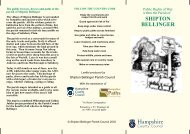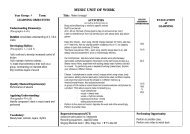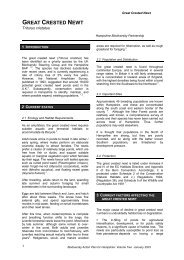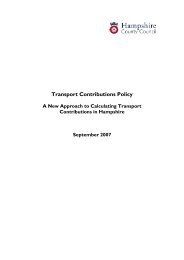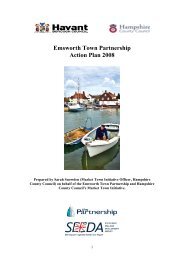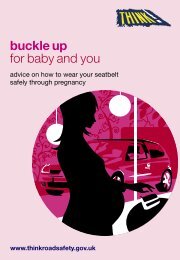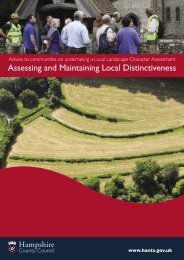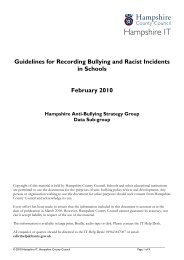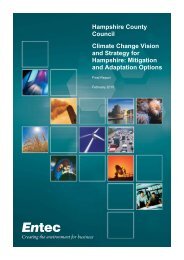erf planning.indd - Hampshire County Council
erf planning.indd - Hampshire County Council
erf planning.indd - Hampshire County Council
- No tags were found...
Create successful ePaper yourself
Turn your PDF publications into a flip-book with our unique Google optimized e-Paper software.
At the end of this process the forums recommended a broad strategy based on anintegrated approach to household waste that would:• minimise the production of waste• develop recycling and composting• address the residual wastes.They also made recommendations as to the key issues that needed to be addressed inorder to reduce concerns over incineration, and asked that a non-incineration option besought in a future contracting process. All three forums came to broadly similar conclusions.In response to this, the <strong>County</strong> <strong>Council</strong> decided that the best way to address thecommunity aspirations was to set up three waste disposal contracts – one for eachof the geographic divisions of <strong>Hampshire</strong>. What was signifi cantly different with theproposed contracts from those that preceded them was that they were based on theprovision of a service with p<strong>erf</strong>ormance targets, rather than just requiring the provisionand operation of infrastructure. It was perhaps one of the fi rst output contracts in publicsector waste management.As a result of the tendering process, <strong>Hampshire</strong> Waste Services (HWS) – a wholly ownedsubsidiary of the Onyx Environmental Group (now Veolia Environmental Services) – wasselected as the contractor for the services in all three areas. <strong>Hampshire</strong> Waste Servicesoffered a menu of infrastructure options to meet the service objectives, including three ERFplants, four Material Recovery Facilities (MRFs), three composting sites and a network oftransfer facilities to enable the materials and waste streams to be transported in a moreeffi cient manner. As with other tenderers, HWS offered landfi ll as their non-incineration option.The new contract started on 1 January 1996, following which the <strong>County</strong> <strong>Council</strong>undertook a further round of public consultation on the infrastructure options and over70% of respondents supported the incineration proposals. This consultation usedmarket research and focus groups to seek views from the normally “silent majority”.These fi ndings allowed the strategy to be fi rmed up as follows:• keep waste arisings at 1995 levels• 25% recycling rate by 2000, with a target of 40% in the longer term• three small scale incinerators dealing with 75% of residual waste• landfi ll for the waste left over, including process residues.As part of the contract, a partnership approach was initiated that brought in thewaste collection authorities so that all public and private players were engaged in anintegrated approach to waste management. Project Integra was born.



